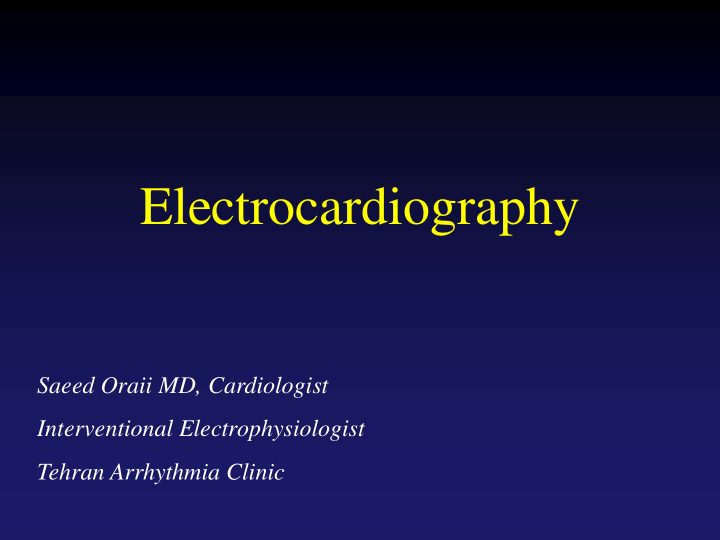



Evolution of a Myocardial Infarction • When myocardial blood supply is abruptly reduced or cut off to a region of the heart, a sequence of injurious events occur beginning with ischemia (inadequate tissue perfusion), followed by necrosis (infarction), and eventual fibrosis (scarring) if the blood supply isn't restored in an appropriate period of time. • The ECG changes over time with each of these events… Tehran Arrhythmia Center
ST Elevation Infarction The ECG changes seen with a ST elevation infarction are: Before injury Normal ECG Peaked T-waves, then T-wave inversion, ST Ischemia depression, Infarction ST elevation & appearance of Q-waves ST segments and T-waves return to normal, Fibrosis but Q-waves persist Tehran Arrhythmia Center
Acute Ischemia Tehran Arrhythmia Center
ST Elevation A great way to diagnose an acute MI is to look for elevation of the ST segment. Tehran Arrhythmia Center
ECG Changes Ways the ECG can change include: ST elevation & depression T-waves peaked flattened inverted Appearance of pathologic Q-waves Tehran Arrhythmia Center
ST Elevation Elevation of the ST segment (greater than 1 small box) in 2 leads is consistent with a myocardial infarction. Tehran Arrhythmia Center
ST Elevation Infarction Evolving infarction: A. Normal ECG prior to MI B. Ischemia from coronary artery occlusion results in ST depression (not shown) and peaked T- waves C. Infarction from ongoing ischemia results in marked ST elevation D/E. Ongoing infarction with appearance of pathologic Q-waves and T-wave inversion F. Fibrosis (months later) with persistent Q- waves, but normal ST segment and T- waves Tehran Arrhythmia Center
Views of the Heart Some leads get a Lateral portion good view of the: of the heart Anterior portion of the heart Inferior portion of the heart Tehran Arrhythmia Center
Anterior MI Remember the anterior portion of the heart is best viewed using leads V 1 - V 4 . Limb Leads Augmented Leads Precordial Leads Tehran Arrhythmia Center
Lateral MI The lateral portion of the heart is best viewed by: Leads I, aVL, and V 5 - V 6 Limb Leads Augmented Leads Precordial Leads Tehran Arrhythmia Center
Inferior MI The inferior portion of the Leads II, III and aVF heart by: Limb Leads Augmented Leads Precordial Leads Tehran Arrhythmia Center
Inferior Wall MI Note the ST elevation in leads II, III and aVF. Tehran Arrhythmia Center
Anterolateral MI This person’s MI involves both the anterior wall (V 2 - V 4 ) and the lateral wall (V 5 -V 6 , I, and aVL)! Tehran Arrhythmia Center
Myocardial Infarction Tehran Arrhythmia Center
Non-ST Elevation MI Non-ST Elevation There are two distinct patterns of ECG change depending if the infarction is: ST Elevation – ST Elevation (Transmural or Q-wave), or – Non-ST Elevation (Subendocardial or non-Q-wave) Tehran Arrhythmia Center
Non-ST Elevation Infarction ECG of an evolving non-ST elevation MI: Note the ST depression and T-wave inversion in leads V 2 -V 6 . Question: What area of the heart is infarcting? Cannot say! Tehran Arrhythmia Center
Acute Pericarditis Tehran Arrhythmia Center
Metabolic Abnormalities Tehran Arrhythmia Center
Hyper- kalemia K 6.9 Tehran Arrhythmia Center
Same patient K 3.9 Tehran Arrhythmia Center
Recommend
More recommend